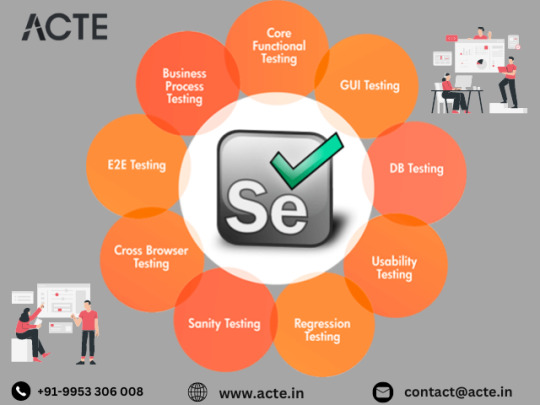#selenium courses
Explore tagged Tumblr posts
Text
Revolutionizing Web Testing: A Deep Dive into Selenium's Automation Dynamics
In the rapidly evolving digital arena, the assurance of flawless functionality, optimal performance, and responsiveness of web applications is a non-negotiable aspect of software development. Selenium, an open-source automation framework, emerges as a formidable force in achieving these objectives. In this comprehensive exploration, we will delve into the intricacies of Selenium, unraveling its role in automation, dissecting the components comprising its toolkit, and understanding its profound impact on modern web testing practices.

1. Decoding Selenium: A Core Element of Automation Mastery
At its essence, Selenium represents a suite of tools meticulously crafted to automate web browsers. This automation plays a pivotal role in the testing domain, where the simulation of user interactions is imperative for validating the functionality and performance of web applications. Beyond testing, Selenium significantly contributes to the efficiency and reliability of the software development lifecycle.
2. The Toolbox Essentials: Navigating Selenium's Arsenal
Selenium's toolkit comprises three indispensable components, each serving a distinct purpose in the automation journey.
Selenium IDE:
Selenium IDE, a browser extension, simplifies the recording, editing, and debugging of tests. With a user-friendly interface, testers can effortlessly create and modify test cases.
Selenium WebDriver:
The crux of Selenium lies in WebDriver, a tool facilitating interaction with web browsers through diverse programming languages. This component is instrumental in crafting dynamic and programmable test scripts.
Selenium Grid:
Selenium Grid acts as a scalable solution enabling parallel test execution across multiple machines and browsers. This feature expedites the testing process by distributing test cases effectively.
3. Language Flexibility: Adaptable Automation at its Finest
A standout feature of Selenium is its support for multiple programming languages, including Java, Python, C#, and Ruby. This flexibility empowers testers and developers to harness Selenium's capabilities within their preferred programming language, fostering seamless integration into existing workflows.
4. Cross-Browser Compatibility: Ensuring Uniformity in Diversity
Selenium's prowess shines in its ability to conduct cross-browser testing with efficiency. In the era where web applications must perform consistently across various browsers, Selenium ensures uniformity in testing scenarios across Chrome, Firefox, Safari, and more. This cross-browser compatibility is paramount for delivering a consistent user experience.

5. Dynamic Web Element Handling: Mastering Change
In the dynamic landscape of web development, the adept handling of dynamic web elements stands as a critical testing aspect. Selenium excels in providing robust mechanisms to identify and interact with elements that undergo changes based on user interactions. This adaptability guarantees accurate testing even in scenarios where web elements are subject to modification.
6. Integration with Testing Frameworks: Orchestrating Efficient Test Management
Selenium seamlessly integrates with renowned testing frameworks like JUnit and TestNG. This integration enhances the efficiency of test management, execution, and reporting. Testing frameworks offer a structured approach to test development, simplifying the management, execution, and analysis of test results.
7. Parallel Test Execution: Turbocharging Processes
Selenium Grid emerges as a powerhouse solution for accelerating test execution. By facilitating parallel execution of tests across multiple machines and browsers, Selenium Grid substantially reduces test execution time. This parallelization proves invaluable, especially when dealing with extensive test suites that require swift execution.
8. Community Support and Continuous Advancement: Sustaining an Ecosystem
Selenium thrives on the strength of its community. With a dynamic community of developers, testers, and automation enthusiasts, Selenium undergoes continuous refinement and enhancement. Regular updates, bug fixes, and the introduction of new features ensure that Selenium aligns seamlessly with the ever-evolving web technology landscape.
Conclusion: Selenium as the Cornerstone of Automated Precision
In conclusion, Selenium stands tall as a cornerstone in the realm of automation, particularly in web testing. Its adaptability, cross-browser testing capabilities, integration with testing frameworks, and support for parallel test execution position it as an indispensable tool for ensuring the quality and reliability of web applications.
Whether you're a seasoned tester or a developer navigating the intricacies of web testing, Selenium equips you to streamline your testing processes. Its impact resonates in the delivery of high-quality software, contributing to the seamless user experience expected in the dynamic digital landscape.
As we delve into the myriad facets of Selenium, we uncover its transformative power in reshaping testing practices and fortifying the foundations of robust and reliable web applications. Embrace the influence of Selenium, and let it be your guiding force in the captivating journey of web automation.
4 notes
·
View notes
Text
Pioneering the Future of Software Quality Assurance through Automation Testing
Automation testing, a dynamic and essential software quality assurance technique, is reshaping the landscape of application testing. Its mission is to execute predefined test cases on applications, delivering heightened accuracy, reliability, and efficiency by automating tedious and time-consuming testing tasks.

The Present and Future Synergy in Automation Testing:
At its essence, automation testing responds to the pressing need for a streamlined testing process. Beyond its current significance, the future promises a paradigm shift, characterized by transformative trends and advancements.
Unveiling Future Trends in Automation Testing:
Proactive "Shift-Left" Testing: Embracing a proactive "Shift-Left" approach, the future of automation testing integrates testing earlier in the development life cycle. This strategic shift aims to detect and address issues at their inception, fostering a more resilient and efficient software development process.
Harmonizing with DevOps: Automation is positioned to become increasingly integral to DevOps practices. Its seamless integration into continuous integration and delivery (CI/CD) pipelines ensures not just faster but more reliable releases, aligning seamlessly with the agile principles of DevOps.
AI and Machine Learning Synergy: The convergence of artificial intelligence (AI) and machine learning (ML) is poised to revolutionize automation testing. This integration enhances script maintenance, facilitates intelligent test case generation, and empowers predictive analysis based on historical data, ushering in a new era of adaptive and efficient testing processes.

Evolving Cross-Browser and Cross-Platform Testing: In response to the diversification of the software landscape, automation tools are evolving to provide robust solutions for cross-browser and cross-platform testing. Ensuring compatibility across diverse environments becomes paramount for delivering a seamless user experience.
Codeless Automation Revolution: The ascent of codeless automation tools represents a pivotal shift in testing methodologies. This trend simplifies testing processes, enabling testers with limited programming skills to create and execute automated tests. This democratization of testing accelerates adoption across teams, fostering a collaborative testing environment.
Concluding the Journey: Navigating Future Imperatives:
In conclusion, automation testing transcends its current role as a necessity, emerging as a future imperative in the ever-evolving landscape of software development. As technologies advance and methodologies mature, automation testing is poised to play a pivotal role in ensuring the delivery of high-quality software at an accelerated pace. Embracing these future trends, the software industry is set to embark on a transformative journey towards more efficient, adaptive, and reliable testing processes.
3 notes
·
View notes
Text
Discovering the Building Blocks of Selenium in Simple Terms

Selenium IDE (Integrated Development Environment)
Think of Selenium IDE as a special notepad for recording what you do on a website. It’s like a diary that writes down the things you do on the internet. This is a simple way to start testing websites. Selenium IDE (Integrated Development Environment) is the simplest tool in the Selenium Suite. It is a Firefox add-on that creates tests very quickly through its record-and-playback functionality. This feature is similar to that of QTP. It is effortless to install and easy to learn.
Selenium WebDriver
Now, let’s get a little technical. WebDriver is like the engine that makes your testing happen. It’s a set of tools for different computer languages, like Java or Python. These tools help you do things on a website, like clicking buttons or filling out forms, just like a real person. Selenium WebDriver is a browser automation framework that accepts commands and sends them to a browser. It is implemented through a browser-specific driver. It directly communicates with the browser and controls it. Selenium WebDriver supports various programming languages like Java, C#, PHP, Python, Perl, and Ruby.
Selenium Grid
When you want to test on different internet browsers at the same time, that’s where Selenium Grid comes in. It helps you spread your tests across different computers to make sure everything works on different browsers and devices. Hub is a server that accepts access requests from the WebDriver client, routing the JSON test commands to the remote drives on nodes.
Selenium Client Libraries
Remember those tools I mentioned earlier? Client libraries are like special helpers that let you use those tools in your favourite computer language. They help you talk to WebDriver. So, whether you like Java, Python, or something else, you can use Selenium without any problems. The Selenium Client Library consists of various language libraries for Java, Ruby, Python, and other supported languages. JSON denotes Java script Object Notation.
Third-party frameworks and tools
Selenium can do even more when you use it with other tools. These tools help you organise your tests and make them easier to understand. They can also help you test mobile apps and other things. Selenium frameworks based on the functional approach are classified into three main types: Data-driven framework. keyword-driven framework. Hybrid framework.
Browsers and Web Drivers

Selenium is a great tool for testing websites. Its parts, from Selenium IDE for recording what you do to WebDriver for doing things on websites and Selenium Grid for testing on different browsers, work together to make testing easier. With Selenium, you can make sure your websites work well on different browsers and devices. So, next time you want to test a website, remember that Selenium is there to help you. Happy testing! To dive deeper into Selenium and unlock its full potential, consider reaching out to ACTE Technologies, a leading provider of certifications and job placement opportunities in the field of Selenium. Their experienced staff can guide you on your journey to mastering this versatile tool.
2 notes
·
View notes
Text

What is automation testing?
Automation testing is a testing method where automated tools are used to run test cases automatically and verify an application's functionality. Rather than verifying all things manually, the tester creates scripts or utilizes tools to run tests, verify actual versus expected results, and generate reports.
It helps to:
i) Savings of time on routine work
ii) Improving precision by reducing human error
iii) Improving test coverage
iv) Speeding up development cycles
v) Some popular tools are Selenium, TestNG, Jenkins, and Appium.
Popular tools include Selenium, TestNG, Jenkins, and Appium.
Skyappz Academy is a career-oriented professional training organization in Coimbatore which is popular for providing career-oriented IT training programs to acquaint the student with current technology industry requirements. With the assistance of Skyappz Software Solutions, the academy provides practical, real-time training under the supervision of expert industry professionals.
0 notes
Text
What Are the Key Benefits of Learning Selenium Testing?
Introduction: Why Selenium Testing Is in Demand
Are you looking to break into the world of automation testing or advance your QA career? Then Selenium Testing might just be your best move.
With the rapid adoption of automation in software development, companies are seeking professionals who can test faster, more efficiently, and with fewer bugs. Selenium stands out as one of the most in-demand automation testing tools in the industry. Whether you're a beginner or looking to upgrade your skills, Selenium Training opens the door to a range of career opportunities.
In this blog, we’ll explore the key benefits of learning Selenium Testing, why it has become the go-to tool for testers, and how you can kick-start your journey with Online Selenium training.
What Is Selenium Testing?
Selenium is an open-source automation testing tool used to validate web applications across different browsers and platforms. It supports multiple programming languages like Java, Python, C#, and JavaScript.
Selenium is not a single tool but a suite consisting of:
Selenium IDE (Integrated Development Environment)
Selenium WebDriver
Selenium Grid
Selenium RC (now deprecated)
This flexibility and versatility have made it a staple in test automation frameworks across the globe.
Why Learn Selenium Testing?
The Top Benefits of Enrolling in Selenium Training
Let’s break down the most impactful advantages of learning Selenium automation testing:
1. High Demand in the Job Market
Selenium Testing is among the top skills recruiters look for in QA professionals. Companies across industries—IT, finance, healthcare, e-commerce—seek testers with Selenium knowledge.
📌 Job portals list thousands of Selenium-related roles globally. Learning Selenium can help you tap into this fast-growing demand.
Keywords Integrated: Selenium Training, Selenium Testing, Selenium certification
2. Open-Source and Cost-Free
Unlike many proprietary tools, Selenium is completely free. This makes it a popular choice for companies and individuals alike. You don’t need to worry about licensing costs or restrictions, which also increases your job readiness with real-world tools.
3. Cross-Browser Compatibility
Selenium allows you to run tests on multiple browsers including Chrome, Firefox, Safari, Edge, and more. This browser compatibility makes Selenium an essential skill for testers who need to validate UI across environments.
🧪 Real-World Use Case: E-commerce platforms use Selenium to ensure their websites render and function consistently across all major browsers.
Keywords Integrated: selenium software testing, Selenium course, Selenium course online
4. Supports Multiple Programming Languages
Whether you’re a Java enthusiast or a Python fan, Selenium supports various programming languages:
Java
Python
C#
JavaScript
Ruby
This multi-language support gives testers the freedom to work in the language they’re most comfortable with.
5. Integration with Popular DevOps Tools
Selenium integrates seamlessly with tools used in Continuous Integration and Continuous Deployment (CI/CD) pipelines such as:
Jenkins
Maven
TestNG
Docker
This makes Selenium an integral part of modern software development and testing practices.
Keywords Integrated: Selenium course training, Selenium certification course
6. Community Support and Extensive Documentation
Selenium has a massive user base and an active community. Whether you're stuck on a coding issue or looking for best practices, chances are someone has already solved it and shared the solution.
✅ Online forums, documentation, and GitHub repositories provide excellent resources for beginners.
7. Suits Both Beginners and Experienced Testers
If you're new to automation, Selenium training for beginners provides a structured way to learn the fundamentals. If you’re already experienced, Selenium lets you build advanced test cases, frameworks, and integrations.
🧠 Selenium’s modular architecture makes it easy to grow your skill set gradually.
8. Increased Testing Efficiency
Manual testing is time-consuming. Selenium automates repetitive test cases, which boosts efficiency and allows QA teams to focus on more complex testing scenarios.
🚀 Companies that automate with Selenium report significant reductions in time-to-release.
9. Flexibility in Framework Design
Selenium supports a wide range of automation frameworks:
Hybrid Framework
Data-Driven Framework
Keyword-Driven Framework
Page Object Model (POM)
This makes Selenium adaptable for small teams as well as enterprise-scale applications.
10. Real-Time Project Experience in Courses
High-quality Selenium certification training often includes real-time project scenarios. This hands-on experience is vital in making you job-ready.
💡 Practical exposure prepares you to handle real-world challenges from Day One in your job.
11. Higher Salary Packages
Automation testers with Selenium expertise often command higher salaries compared to manual testers. Your earning potential increases with certification and real-world project experience.
💰 Glassdoor and PayScale report that Selenium testers in the U.S. earn an average of $80,000–$110,000 annually.
12. Easy to Learn and Implement
Selenium has a gentle learning curve compared to other tools. With structured Selenium course training, you can go from zero to automation expert without needing a coding background.
📘 Step-by-step tutorials, IDEs like Eclipse, and frameworks make learning simple and efficient.
13. Global Recognition and Career Mobility
Once you're certified in Selenium Testing, you open doors to opportunities worldwide. Selenium is used by organizations across countries, making it a globally recognized skill.
14. Excellent for Freelancing and Remote Work
Because it’s widely used and cloud-compatible, Selenium testers can work remotely or freelance. It’s a great option for those seeking flexibility and independence in their career.
15. Build a Long-Term Career in QA Automation
Selenium lays the foundation for roles like:
Automation Test Engineer
QA Analyst
Test Architect
Performance Tester
SDET (Software Development Engineer in Test)
These roles are evolving with industry trends, and Selenium is a skill that continues to stay relevant.
How to Start Learning Selenium Testing
Getting started with Selenium is easier than ever. Here’s a simple roadmap for beginners:
Step 1: Learn Manual Testing Basics
Understand test cases, test plans, bug reporting, and QA concepts.
Step 2: Choose a Programming Language
Java is widely used with Selenium, but Python is beginner-friendly.
Step 3: Enroll in a Structured Selenium Course Online
Look for a course that includes hands-on projects, quizzes, and real-world assignments.
Step 4: Work on Real-Time Projects
Apply your knowledge in simulated or live environments to gain practical skills.
Step 5: Prepare for Selenium Certification
Certification enhances credibility and increases your chances of getting hired faster.
Conclusion: Your Next Step Toward a Testing Career
Learning Selenium Testing is more than just a skill—it’s a smart investment in your future. Whether you’re a beginner or a QA professional looking to advance, mastering Selenium can elevate your career to new heights.
Ready to accelerate your testing career? Enroll in H2K Infosys' hands-on Selenium course today and become a job-ready automation tester!
#Selenium Training#Selenium Training online#Selenium certification#Selenium certification training#Selenium certification course#Selenium course#Selenium course online#Selenium course training#Selenium training for beginners#Selenium Testing#Online Selenium training#selenium automation testing#selenium software testing
0 notes
Text
The Future of Testing: How Selenium Automation Testing is transforming the Industry

Introduction
What is quality assurance and testing? Increasing complexity in modern applications has made manual testing difficult, as it is not only time-consuming but also inefficient. Here is where Selenium automation testing is making a difference in the industry, from being reliable and scalable to a fast solution for testing software.
What is selenium automation testing?
Selenium is an open-source framework for automating web-based applications across various browsers and platforms. Selenium models at automated tests, thus running much more efficiently and effectively than general manual testing. Selenium is an extremely versatile and flexible solution, as developers and testers can write scripts in various programming languages, including Java, Python, C#, Ruby, and JavaScript.
Opening New Avenues in Software Testing with Selenium
1. Cross-Browser Compatibility
Another great advantage of Selenium automation testing is that it supports multiple browsers such as Google Chrome, Mozilla Firefox, Safari, Edge, and Internet Explorer. This guarantees that web applications operate uniformly across various settings, erasing browser-related problems.
2. Integrate with CI/CD Pipelines
As organizations embrace DevOps and CI/CD at scale, Selenium works with popular tools such as Jenkins, Bamboo, and GitHub Actions. This enables
3. Parallel Test Execution for Speed and Efficiency
Manual testing requires significant time and resources. Selenium Grid, an advanced feature of Selenium, allows parallel test execution across multiple machines and browsers. This drastically reduces the time needed for testing, ensuring rapid feedback and improved software quality.
4. Cost-Effectiveness and Open-Source Advantage
Because Selenium is entirely free and open-source, in contrast to many commercial testing tools, it is a great option for start-ups, small businesses, and major companies. Updates, bug fixes, and new features are continuously accessible because of the strong community support.
5. Flexible Language Support
Selenium supports a wide array of programming languages, including:
Java
Python
C#
Ruby
JavaScript
Test script development is made easier and more efficient by this flexibility, which enables test automation engineers to work with a language they are familiar with.
Essential Elements of Selenium Automation
1. Selenium WebDriver
WebDriver, the core component of Selenium, works directly with web browsers to perform user actions including text input, button clicks, and page scrolling. It offers faster execution and enables headless browser testing for better performance.
2. The IDE for Selenium
The main purpose of the record-and-playback Selenium Integrated Development Environment (IDE) is to facilitate the rapid construction of test scripts. For novices wishing to begin test automation without extensive programming experience, it is perfect.
3. Grid Selenium
Selenium Grid drastically cuts down on test execution time by enabling parallel test execution across several computers and settings. Large-scale enterprise applications that need a lot of regression testing will find it especially helpful.
Selenium Automation Testing Best Practices
1. Make use of the POM (Page Object Model)
A design pattern called the Page Object Model (POM) improves the reusability and maintainability of test scripts. Teams can readily alter test cases without compromising the main framework by keeping UI components and test logic separate.
2. Implement Data-Driven Testing
Using frameworks like TestNG and JUnit, testers can implement data-driven testing, allowing them to run test scripts with multiple sets of input data. This ensures broader test coverage and better validation of application functionality.
3. Make Use of Headless Browser Evaluation Using browsers like Chrome Headless and PhantomJS to run tests in headless mode (without a GUI) expedites test execution, which makes it perfect for CI/CD pipelines. 4. Include Exception Management Testers should use explicit waits, implicit waits, and try-catch blocks to improve the resilience of test scripts and avoid test failures caused by small problems like network delays or element loading times. 5. Constant Tracking and Reporting Teams can more efficiently examine test results and monitor issues over time by integrating test reporting solutions such as Extent Reports, Allure, or TestNG Reports.
Selenium Automation Testing's Future
Because of updating in artificial intelligence (AI) and machine learning (ML), Selenium automation testing seems to have a bright future.
Emerging AI-driven self-healing test automation frameworks enable scripts to dynamically adjust to UI changes, minimizing maintenance requirements. Furthermore, scalable, on-demand test execution is made possible by the integration of cloud-based testing platforms such as Sauce Labs, browser stack, and Lambda Test, guaranteeing high performance in international settings.
Conclusion
By increasing productivity, reducing expenses, and raising software quality, Selenium automation testing is transforming the software testing sector rapidly. It is an essential tool for modern software development teams due to its adaptability, cross-browser compatibility, and integration capabilities. Businesses may use Selenium automation's advantages and maintain their competitive edge in the current digital environment by putting best practices into effect, utilizing parallel execution, and integrating with CI/CD pipelines. Advanto Software in Pune offers the best Selenium Automation Testing Courseat an affordable price with 100% placement assistance.
Join us today: www.profitmaxacademy.com/
0 notes
Text
Handling dynamic elements in Selenium requires using explicit waits (WebDriverWait) to wait for elements to appear, leveraging dynamic XPath or CSS selectors, and using JavaScript executors to interact with elements.
0 notes
Text
From Beginner to Pro: Dominate Automated Testing with Our Selenium Course
Welcome to our comprehensive Selenium course designed to help individuals from all backgrounds, whether novice or experienced, enhance their automated testing skills and become proficient in Selenium. In this article, we will delve into the world of Selenium, an open-source automated testing framework that has revolutionized software testing. With our course, we aim to empower aspiring professionals with the knowledge and techniques necessary to excel in the field of automated testing.

Why Choose Selenium?
Selenium offers a wide array of features and capabilities that make it the go-to choice for automated testing in the IT industry.
It allows testers to write test scripts in multiple programming languages, including Java, Python, C#, and more, ensuring flexibility and compatibility with various project requirements.
Selenium’s compatibility with different web browsers such as Chrome, Firefox, Safari, and Internet Explorer makes it a versatile choice for testing web applications.
The ability to leverage Selenium WebDriver, which provides a simple and powerful API, allows for seamless interaction with web elements, making automating tasks easier than ever before.
Selenium’s Key Components:
Selenium IDE:
Selenium Integrated Development Environment (IDE) is a Firefox plugin primarily used for recording and playing back test cases. It offers a user-friendly interface, allowing even non-programmers to create basic tests effortlessly.
Although Selenium IDE is a valuable tool for beginners, our course primarily focuses on Selenium WebDriver due to its advanced capabilities and wider scope.
Selenium WebDriver:
Selenium WebDriver is the most critical component of the Selenium framework. It provides a programming interface to interact with web elements and perform actions programmatically.
WebDriver’s functionality extends beyond just browser automation; it also enables testers to handle alerts, pop-ups, frames, and handle various other web application interactions.
Our Selenium course places significant emphasis on WebDriver, equipping learners with the skills to automate complex test scenarios efficiently.
Selenium Grid:
Selenium Grid empowers testers by allowing them to execute tests on multiple machines and browsers simultaneously, making it an essential component for testing scalability and cross-browser compatibility.
Through our Selenium course, you’ll gain a deep understanding of Selenium Grid and learn how to harness its capabilities effectively.

The Benefits of Our Selenium Course
Comprehensive Curriculum: Our course is designed to cover everything from the fundamentals of automated testing to advanced techniques in Selenium, ensuring learners receive a well-rounded education.
Hands-on Experience: Practical exercises and real-world examples are incorporated to provide learners with the opportunity to apply their knowledge in a realistic setting.
Expert Instruction: You’ll be guided by experienced instructors who have a profound understanding of Selenium and its application in the industry, ensuring you receive the best possible education.
Flexibility: Our course offers flexible learning options, allowing you to study at your own pace and convenience, ensuring a stress-free learning experience.
Industry Recognition: Completion of our Selenium course will provide you with a valuable certification recognized by employers worldwide, enhancing your career prospects within the IT industry.
Who Should Enroll?
Novice Testers: If you’re new to the world of automated testing and aspire to become proficient in Selenium, our course is designed specifically for you. We’ll lay a strong foundation and gradually guide you towards becoming a pro in Selenium automation.
Experienced Testers: Even if you already have experience in automated testing, our course will help you enhance your skills and keep up with the latest trends and best practices in Selenium.
IT Professionals: Individuals working in the IT industry, such as developers or quality assurance engineers, who want to broaden their skillset and optimize their testing processes, will greatly benefit from our Selenium course.
In conclusion, our Selenium course is a one-stop solution for individuals seeking to dominate automated testing and excel in their careers. With a comprehensive curriculum, hands-on experience, expert instruction, and industry recognition, you’ll be well-prepared to tackle any automated testing challenges that come your way. Make the smart choice and enroll in our Selenium course at ACTE Technologies today to unlock your full potential in the world of software testing.
7 notes
·
View notes
Text
Navigating the Future: Thriving in Automation Testing Careers
In the dynamic landscape of technology, the future of automation testing emerges as a strategic and rewarding career choice, offering enduring prospects and continuous evolution. Here's a deep dive into why automation testing is not just a profession but a journey towards a future filled with opportunities and advancements.

1. Pioneering Technological Evolution: Positioned at the forefront of technological advancements, automation testing serves as a trailblazer, ensuring seamless adaptation to emerging technologies and future innovations.
2. Anchored in Agile and DevOps Realms: The widespread embrace of Agile and DevOps methodologies propels automation testing to the forefront. In an era demanding rapid software releases, automation testing becomes the linchpin for maintaining speed and reliability in development cycles.
3. Surging Demand for Quality Assurance: The escalating complexity of modern software necessitates robust quality assurance processes. Automation testing provides a systematic and efficient approach, meeting the rising demand for top-tier quality in software applications.
4. Efficiency Unleashed: A standout advantage of automation testing lies in its prowess to significantly reduce testing time and costs. Rapid and repetitive execution of automated tests enables efficient bug identification, ensuring swift development cycles.
5. Cross-Industry Versatility: The adaptability of automation testing transcends industry boundaries. Professionals can explore diverse opportunities across sectors like healthcare, finance, e-commerce, and gaming, opening up a spectrum of career avenues beyond conventional limits.

6. Skills Cultivation and Career Ascension: Opting for a career in automation testing provides an enriching environment for skill development. Mastery of automation tools, programming languages, and staying abreast of industry trends pave the way for substantial career growth. Roles such as automation test engineer, test architect, or quality assurance manager showcase the diverse career paths within reach.
7. Fostering Software Reliability: At the core of automation testing is its pivotal role in ensuring the reliability and performance of software applications. Early identification and resolution of issues in the development process contribute to delivering high-quality software products to end-users.
In conclusion, the future of automation testing is a voyage—an exploration of opportunities and advancements. For individuals with a tech-savvy mindset, attention to detail, and a commitment to software quality, choosing a career in automation testing is a forward-thinking and fulfilling decision. As the industry continues to pivot towards automated testing solutions, it remains a field of enduring relevance, promising a future rich with opportunities and impact.
3 notes
·
View notes
Text
In-Depth Comparison of Java and Python for Selenium Automation Frameworks
When it comes to automating web testing, Selenium stands out as a widely-used and powerful tool. Developers often face the decision of choosing the right programming language to pair with Selenium, and two of the most popular contenders are Java and Python. Each has its strengths and use cases, but they cater to different needs in Selenium automation. If you want to advance your career at the Selenium Course in Pune, you need to take a systematic approach and join up for a course that best suits your interests and will greatly expand your learning path. Let’s delve into an in-depth comparison of Java and Python for Selenium automation frameworks.

1. Enterprise Adoption and Ecosystem
Java is a cornerstone language in enterprise environments, with extensive adoption across large-scale applications. Its compatibility with existing enterprise systems and robust support for integrating automation frameworks like Selenium make it a go-to choice for organizations. On the other hand, Python is favored in startups and smaller-scale projects due to its simplicity and faster learning curve. For those looking to excel in Selenium, Selenium Online Course is highly suggested. Look for classes that align with your preferred programming language and learning approach.
2. Performance and Scalability
Java’s Just-In-Time (JIT) compiler optimizes code execution, ensuring superior performance for large and complex test suites. This makes Java ideal for scenarios requiring high scalability. Python, while adequate for smaller projects, may face performance bottlenecks in handling extensive parallel testing due to its Global Interpreter Lock (GIL).
3. Ease of Use and Learning Curve
Python is renowned for its simple and readable syntax, making it an excellent choice for beginners in automation testing. Java, with its verbose syntax and steeper learning curve, is better suited for experienced developers who value its strong typing and error detection capabilities.
4. Community and Support
Both Java and Python have extensive communities, but Java’s longstanding association with Selenium gives it a slight edge in terms of resources. Since Selenium was initially developed with Java, there are more tutorials, libraries, and forums available for Java-based Selenium testing. Python also has strong community support, particularly for data-driven and AI-based testing scenarios.
5. Testing Frameworks and Libraries
Java offers a rich ecosystem of testing frameworks like TestNG and JUnit, providing advanced features such as parameterized testing, detailed reporting, and parallel execution. Python, on the other hand, boasts flexible and lightweight libraries like PyTest, which are easier to set up but may lack some of the advanced capabilities offered by Java frameworks.

6. Error Detection and Debugging
Java’s static typing system helps identify errors during compilation, reducing runtime failures and enhancing reliability in complex projects. Python, being dynamically typed, allows for faster prototyping but increases the likelihood of runtime errors in larger codebases.
7. Multi-Threading and Parallel Testing
Java excels in multi-threading, making it highly efficient for parallel test execution in Selenium. Python’s multi-threading capabilities are limited by the Global Interpreter Lock (GIL), which can be a disadvantage for projects requiring extensive parallelization.
8. Cross-Browser Testing and Compatibility
Java’s strong bindings with Selenium WebDriver make it highly effective for cross-browser testing, with better support for new browser updates. Python also handles cross-browser testing efficiently but may occasionally lag behind Java in WebDriver support and compatibility.
9. Integration with Enterprise Tools
Java integrates seamlessly with enterprise-level tools and systems, including CI/CD pipelines, database testing frameworks, and reporting tools. Python offers excellent integration with AI and machine learning tools, making it a better choice for data-intensive testing scenarios.
Conclusion
Both Java and Python have their strengths in Selenium automation, but the right choice depends on the project’s requirements. Java shines in enterprise environments, large-scale test suites, and scenarios demanding high performance and scalability. Python, on the other hand, is ideal for smaller projects, rapid prototyping, and scenarios where simplicity is key.
By understanding the unique advantages of each language, testers can select the one that aligns with their goals and technical needs. Whether you opt for Java or Python, both provide the tools needed to build robust and efficient Selenium automation frameworks.
0 notes
Text
Become a Software Testing Expert with Selenium at GVT Academy!

Have you ever wondered how websites run so smoothly? What if a button doesn’t work or a page loads incorrectly? That’s where Software Testing helps! It makes sure that websites work perfectly before users see them. And guess what? Selenium is one of the best tools for this! At GVT Academy, we make learning the Best Selenium testing Course super easy! Whether you are a beginner or want to improve your skills, our expert trainers will guide you every step of the way.
What is Selenium? Selenium is a special tool that automates website testing. Instead of clicking buttons and checking pages manually, Selenium does it for you! This makes testing faster, easier, and more accurate.
Why Should You Learn Selenium? ✅ No need to be a coding expert – You can start as a beginner. ✅ Huge demand for software testers – Companies need Selenium experts. ✅ Saves time and effort – Automate boring and repetitive tasks. ✅ Works with multiple browsers – Test on Chrome, Firefox, and more.
What Will You Learn in Our Course? 🔹 Setting up and installing Selenium easily. 🔹 Writing simple test scripts to check websites. 🔹 Automating form filling, clicking buttons, and page navigation. 🔹 Using Python and Java with Selenium. 🔹 Best practices for professional software testers.
Who Can Join This Course? 👉 Students who want to build a career in tech. 👉 Working professionals looking for a job switch. 👉 Beginners who want to start learning automation testing.
Why Choose GVT Academy? ✨ Expert Trainers – Learn from professionals with real industry experience. ✨ Live Projects – Get hands-on practice with real websites. ✨ Job Assistance – We help you find great job opportunities. ✨ Flexible Timings – Learn at your own pace. Start Your Journey Today! Software testing is an exciting career with high demand and great salaries. Don’t miss this chance to master Selenium and step into the world of Automation Testing. Call/WhatsApp: +91 9718394718 Visit Us: www.gvtacademy.com Email: [email protected] Facebook: www.facebook.com/gvtacademy Instagram: www.instagram.com/gvtacademy X (formerly Twitter): x.com/GVTAcademy Google My Business: https://g.co/kgs/v3LrzxE Let’s learn, test, and automate together!
#gvt academy#selenium course in noida#selenium course#automation#softwaretesting#selenium#gvtacademynoida
0 notes
Text

What is quality assurance and testing? Increasing complexity in modern applications has made manual testing difficult, as it is not only time-consuming but also inefficient. Here is where Selenium automation testing is making a difference in the industry, from being reliable and scalable to a fast solution for testing software.
#selenium automation testing course#advanto selenium automation testing course#best selenium automation testing course
0 notes
Text

🚀 Join eMexo Technologies for an exclusive Selenium With Python Training In Electronic City Bangalore! 💻🌟
📅 When: December 21, 2024 ⏰ Time: 09.00 AM ( IST ) 💻 Mode: Classroom Training 📍 Where: eMexo Technologies, Electronic City, Bengaluru
💡 What makes us different?
✅ Practical, hands-on training ✅ Expert trainers with real-world experience ✅ Job support, mock interviews, & live projects
🌐 Don't miss this opportunity to advance your career. Limited seats available—enroll now!
👉 CLICK https://www.emexotechnologies.com/ to register today! ✍️ 📞 Call us at +91 9513216462 for more info.
#seleniumwithpythontraining#seleniumtesting#selenium course#selenium#python#training#it training institute#emexotechnologies#bangalore#electroniccity#education#careers
0 notes
Text
Manual+Selenium Testing Training Institute
In the rapidly evolving realm of software development, ensuring the quality of applications is critically important. Organizations heavily rely on efficient software testing to deliver seamless user experiences, resulting in a significant demand for skilled testing professionals. For individuals looking to initiate or advance their careers in this thriving industry, it is crucial to gain proficiency in both manual and Selenium testing.
Our Manual + Selenium Testing Training Institute offers an extensive program that combines the thoroughness of manual testing with the efficiency of Selenium automation. Designed for both beginners and experienced practitioners, this course provides the essential skills needed to excel in the software testing domain.
Why Manual Testing Matters
Manual testing remains fundamental in identifying application bugs that automation tools may overlook. It focuses on user experience, helping testers think like end-users to detect critical errors. Our program begins with the essentials, such as creating test plans, designing test cases, executing them, and reporting defects effectively. By mastering these foundational techniques, you’ll be well-prepared to validate software quality before moving to automation.
Why Selenium Is the Future
As the demand for faster testing grows, automation tools like Selenium have become indispensable. Selenium is an open-source framework that supports multiple programming languages, enabling testers to automate web applications across browsers. The course provides in-depth training on Selenium WebDriver, TestNG, Maven, and Jenkins, equipping you with practical knowledge to handle real-world challenges.
What Makes This Course Stand Out?
Comprehensive Curriculum: Learn manual testing principles, Selenium automation, and best practices for seamless integration.
Hands-On Projects: Work on live projects that mimic industry scenarios, ensuring practical exposure.
Expert Guidance: Receive mentorship from experienced trainers with deep knowledge of testing methodologies.
Updated Tools and Techniques: Stay ahead of the curve with the latest in testing frameworks, tools, and strategies.
Career Support: Gain insights into cracking interviews and building a strong portfolio for a successful career.
Who Should Enroll?
This training is ideal for:
Aspiring software testers with no prior experience.
Professionals seeking to enhance their skills by learning automation.
Developers are interested in understanding software testing.
The Road to Success
By the end of the training, you’ll be proficient in manual testing concepts and adept at automating complex test cases with Selenium. You’ll understand defect management, regression testing, and cross-browser testing, enabling you to deliver high-quality software in record time.

Conclusion
The combination of manual and Selenium testing cultivates a comprehensive skill set, equipping you for a dynamic and fulfilling career. Through practical training and expert mentorship, this program effectively connects theoretical understanding with real-world application.
Begin your path to becoming a proficient software tester with our extensive Manual + Selenium Testing Training. This program is offered by Softcrayons Tech Solutions, your reliable partner in achieving professional training excellence.
For more information visit:- https://www.softcrayons.com/manual-selenium-testing-training
0 notes
Text
Deciding Between Selenium with Python and Selenium with Java: An In-Depth Comparison
In the domain of automated testing, Selenium emerges as a pivotal tool for ensuring the reliability and quality of web applications. When it comes to selecting the programming language to harness Selenium's capabilities, two prominent contenders often come into play: Python and Java. Both languages offer distinct advantages and considerations, making the decision between them crucial for any automation project.

In this blog post, we'll conduct a thorough comparison of Selenium with Python and Selenium with Java, exploring their unique strengths, use cases, and factors to consider. By the end, readers will have a clearer understanding of which option aligns best with their project requirements, team proficiencies, and organizational objectives.
Python with Selenium:
Python, celebrated for its simplicity and readability, has garnered significant traction within the automation testing community. Let's delve into some key benefits of leveraging Python with Selenium:
Simplicity and Readability: Python's hallmark characteristics include simplicity and readability. Its concise syntax enables developers to express ideas in fewer lines of code, resulting in scripts that are easier to comprehend and maintain. For testers, this translates to expedited development cycles and reduced overhead in managing test suites.
Extensive Ecosystem: Python boasts a vast ecosystem of libraries and frameworks that complement Selenium, augmenting its capabilities for test automation. Whether handling data manipulation, conducting API testing, or generating test reports, Python's rich library support caters to diverse automation needs. Furthermore, the active Python community ensures an abundance of resources, tutorials, and documentation to aid testers throughout the automation journey.
Rapid Prototyping: Python's dynamic nature lends itself well to rapid prototyping and iterative development. Testers can swiftly experiment with different approaches, adapt scripts on-the-go, and respond promptly to evolving requirements. This flexibility seamlessly aligns with agile development methodologies, empowering teams to deliver high-quality software with agility.
Integration Compatibility: Python's interoperability with other tools and technologies makes it an appealing choice for Selenium automation. Whether integrating with continuous integration (CI) pipelines, test reporting frameworks, or version control systems, Python's versatility ensures smooth interoperability, streamlining the testing workflow and bolstering overall efficiency.

Java with Selenium:
Java, renowned for its robustness and performance, has long been a cornerstone in enterprise software development. Here are some compelling reasons to consider Java for Selenium automation:
Robustness and Performance: Java's static typing and strong object-oriented principles contribute to the robustness and performance of Selenium test suites. Its compile-time error checking aids in identifying potential issues early in the development phase, resulting in more stable and reliable automation scripts. For large-scale enterprise projects with stringent quality requirements, Java's reliability is a significant asset.
Widespread Adoption: Java enjoys widespread adoption within the enterprise landscape, making it a natural choice for organizations with existing Java codebases or a Java-centric development environment. The abundance of Java expertise in the workforce, coupled with extensive community support and industry recognition, solidifies its status as a preferred language for Selenium automation in many corporate settings.
Mature Tooling: Java's mature ecosystem of testing tools and frameworks, including JUnit and TestNG, seamlessly integrate with Selenium to offer comprehensive test automation solutions. These frameworks furnish advanced features such as parameterized testing, parallel execution, and built-in reporting capabilities, empowering testers to design and execute sophisticated test suites effortlessly.
Enterprise Support: Java's popularity in enterprise environments translates to robust support from vendors, extensive documentation, and a plethora of third-party integrations. For organizations seeking enterprise-grade features, reliability, and scalability in their Selenium automation endeavors, Java's ecosystem and support infrastructure present a compelling value proposition.
Conclusion:
In summary, both Selenium with Python and Selenium with Java present compelling options for test automation, each with its unique strengths and considerations. Python excels in simplicity, rapid development, and a vast ecosystem, making it an ideal choice for agile teams and projects with evolving requirements. Conversely, Java offers robustness, performance, and widespread enterprise support, rendering it well-suited for large-scale enterprise applications with stringent quality standards.
Ultimately, the decision between Python and Java for Selenium automation hinges on various factors such as project prerequisites, team proficiencies, and organizational preferences. By meticulously evaluating these factors and weighing the pros and cons of each option, stakeholders can make informed decisions that align with their specific needs and aspirations. Whether opting for the simplicity of Python or the robustness of Java, Selenium remains an indispensable tool for driving quality and efficiency in web application testing.
2 notes
·
View notes